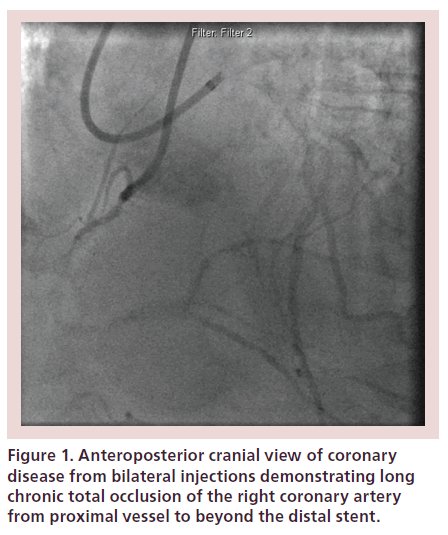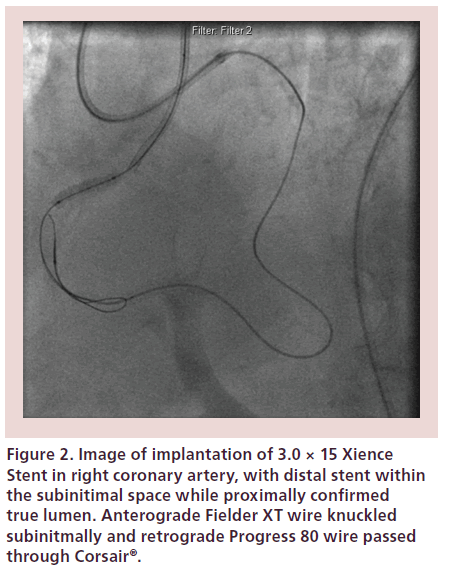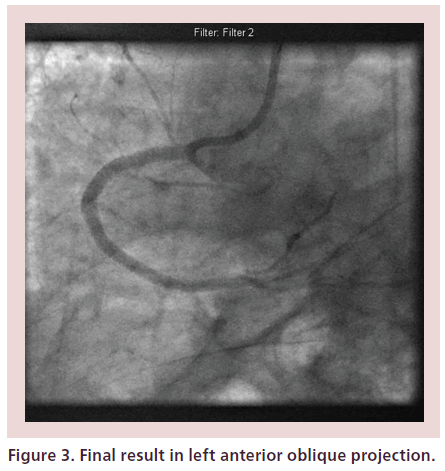Case Report - Interventional Cardiology (2015) Volume 7, Issue 1
A case of stent-facilitated reversecontrolled anterograde and retrograde subintimal tracking technique for chronic occlusion
- Corresponding Author:
- Albert Alahmar
Cardiology Department, Castle Hill Hospital, Castle Road
Cottingham, East Yorkshire, HU16 5JQ, UK
E-mail: ae.alahmar@googlemail.com
Abstract
An elderly patient with previous drug eluting stent (DES) to distal right coronary artery, presented with non-ST elevation myocardial infarction. Angiography showed no l w limitation within the left coronary system, but calcified chronic total occlusi n (CTO) the dominant right coronary artery with retrograde collateralization. He failed medical management and decision was taken for PCI to CTO with primary retr grade reverse controlled antegrade and retrograde subintimal tracking (CART) app ach. The case demonstrates a novel approach using stent to facilitate exte io izing the etr grade wire from false to true lumen. Reverse CART is an established option f CTO PCI, albeit it is not unusual to fail in transition of the retrograde wire from false into t ue lumen. Approaches to facilitate this crucial phase have been described including that above but to our knowledge this is the first publication detailing this complex technique.Keywords
Chronic total occlusion, coronary angiography, coronary angioplasty, coronary artery disease, reverse CART
Chronic total occlusions (CTO) account for a third of all coronary artery disease found on coronary angiography and symbolizes the end stage of the coronary atherosclerotic process [1]. It results in myocardial ischaemia, infarction and reverse remodeling leading to systolic dysfunction [2,3], impacting on both patient morbidity and mortality. Medical therapy has no discernible enhancement in quality of life [4] and neither improvement in survival or LV function [1]. This has led to revascularization being the mainstay of treatment, with both coronary artery bypass graft surgery (CABG) and percutaneous coronary intervention (PCI) being viable options, the latter particularly in patients with single vessel disease or low syntax score [5].
This has driven recent major advances in percutaneous coronary intervention, as studies have supported a significant benefit in outcome in multiple variables including major adverse cardiovascular events, myocardial infarction, all-cause death, angina pectoris, subsequent CABG and cumulative survival in patients successfully recannulized [1,6].
These new strategies have led to an increase in success, particularly with advancement in equipment dedicated to CTO intervention. The development of guidewires for both anterograde and retrograde approaches have revolutionized CTO PCI [7,8,9]; however most studies still report a 65–70% revascularization rate despite this [10,11], with failure of lesion wiring remaining the most common mode of failure [11].
The CART technique is an established option for long complex CTO PCI first defined in 2005 [12]. Describing the predilation of the distal subintimal space on the retrograde wire enabling transition of the anterograde wire into the space and therefore distal true lumen. Further advancement in 2008 resulted in a retrograde (reverse) approach, with predilation of the proximal subintimal space allowing retrograde wire advancement into true lumen, following the conception of the Corsair® microcatheter (Asahi Intecc, Aichi, Japan) [7]. A number of approaches to facilitate the crucial phase of transition of the retrograde wire from false into true lumen have been described including guideliner-assisted technique [13] and stent-facilitated approach described below. To our knowledge the second technique has no publication detailing the complex technique.
Case report
An 83-year-old patient, with background of previous drug eluting stent to distal right coronary artery (RCA) in 2003 and peripheral vascular disease, presented with a non-ST elevation myocardial infarction. Urgent scheduled coronary angiography showed no flow limiting disease within the left coronary system, but CTO of the dominant RCA with retrograde grade 1 Werner collateralization. Echocardiography revealed mild left ventricular systolic dysfunction with hypokinetic mid-apical inferior and posterior walls.
During initial admission a decision was made by the heart team for medical management, with early outpatient review. Standard non-ST elevation myocardial infarction medications were prescribed and antianginals were optimized, he was discharged on appropriate doses of three different class agents. Upon subsequent re-evaluation he continued to experience Canadian Cardiovascular Society Angina Grading Scale class 2 angina. Heart team conclusion was for consideration of PCI, as single vessel disease, with unfavorable comorbidities for (CABG). The options were explained at length with the patient and family, who in light of his symptomatology and detrimental effect on quality of life was willing to accept the risks of PCI against remaining on optimized medical therapy.
Percutaneous coronary intervention was undertaken with 7f access to both right femoral artery and left radial artery. An EBU 3.5 guide intubated the left main stem and AL1, with side holes, guide engaged the RCA ostia. Bilateral contrast injections confirmed finding on diagnostic angiography and supported the primary retrograde strategy (Figure 1). The retrograde approach was favorable given the lesion length with calcification, distal cap proximity to the crux and presence of interventional collaterals. Anterograde options would require a dissection re-entry approach and this would threaten the sizeable posterior left ventricular branch.
A Sion wire (Asahi Intecc, Aichi, Japan) and 150 cm Corsair® microcatheter (Asahi Intecc, Aichi, Japan) were advanced through the septal system into the posterior descending artery progressing easily until distal cap of the occlusion, at the level of previous stent in the distal RCA.
The retrograde wire was exchanged for Pilot 200 (Abbott Vascular International, Diegem, Belgium) and crossed the occluded old stent and through the distal cap allowing delivery of the Corsair® to the middle RCA. Unable to progress further, a decision was made to introduce an anterograde subintimal track to meet the retrograde wire. A Pilot 50 (Abbott Vascular, Diegem, Belgium) was taken through a Finecross microcatheter (Terumo Corp., Tokyo, Japan), escalated to Progress 80 (Abbott Vascular, Diegem, Belgium) and finally Progress 120 (Abbott Vascular, Diegem, Belgium). This entered the subintimal space anterogradely but was unable to meet the retrograde wire. To optimize the subintimal space it was dilated with an Emerge balloon (Boston Scientific Corp., Natick, MA, USA). When this was also futile an Eagle Eye intravascular ultrasound (Volcano Corp., San Diego, CA, USA) probe was taken into the predilated subintimal space to enable visualization of the two lumens and retrograde wire to no avail. So, further anterograde knuckling using Fielder XT (Asahi Intecc, Aichi, Japan) was performed, with no success.
At this stage it is not infrequent to stop the procedure labeled as failed attempt. However, in this case the decision was made to attempt a stent-facilitated procedure, in order to generate a larger target than could be created with either predilation or guideliner assisted, for ease of puncturing into the subintimal space with the retrograde wire. An everolimus 3.0 × 15 stent was positioned connecting the true lumen proximally into the same subintimal space distally (Figure 2).
A larger target lumen enabled rapid reconnection with the true lumen from the retrograde wire with a Progress 80 (Supplementary material; see online at: www. futuremedicine.com/doi/full/10.2217/ICA.14.69). Once the wire engaged the RCA guide the procedure became standard reverse CART with RG3 wire (Asahi Intecc, Aichi, Japan) externalized. Following predilation with serial ballooning 5 overlapping everolimus stents were placed. Final angiographic result was highly satisfactory (Figure 3).
He was discharged the following day on aspirin 75 mg life long and clopidogrel 75 mg daily for 12 months. Subsequent outpatient review has confirmed excellent clinical outcome to support angiographic result. The case demonstrates a novel approach using stent to facilitate exteriorizing the retrograde wire from false to true lumen in reverse CART.
Discussion
The reverse CART, as an adaptation of the standard CART technique, is becoming ‘routine’ practice for experienced CTO operators with 42.5% of retrograde procedures implementing this strategy [14]. The principle is of balloon dilation on the anterograde wire optimizing the re-entry space for the retrograde wire. Thus providing more options in cases previously rejected due to certain angiographic characteristics such as blunt occlusion with a large side branch, bridging collaterals, calcification and long CTO [7]. This case describes how the optimization of the re-entry space can be escalated, with the advantage of the stent forming a clear open target, enabling rapid advancement of the retrograde wire into the proximal true lumen. Once the retrograde wire engages the true lumen the approach is standard reverse CART, with externalization of a long wire and PCI via the anterograde direction.
Conclusion
Diverse knowledge of tips and tricks in CTO PCI is essential to ensure high success, improving patient outcomes. CART and reverse CART technique will continue to become increasingly common place in complex CTO procedures and this case describes another option in the armament to facilitate the wire entry into the true lumen with no disadvantage compared with other re-entry strategies.
Future perspective
The domain of CTO percutaneous intervention remains challenging with constant developments in wires, devices and strategies. We think that the dynamic exchange between anterograde and retro-grade approach will continue to dominate the foresee-able future, however if a forward viewing intravascular ultrasound becomes available aiding the anterograde approach then this might become a favorite.
Financial & competing interests disclosure
The authors have no relevant affiliations or financial involvement with any organization or entity with a financial interest in or financial conflict with the subject matter or materials discussed in the manuscript. This includes employment, consultancies, honoraria, stock ownership or options, expert testimony, grants or patents received or pending, or royalties.
No writing assistance was utilized in the production of this manuscript.
Informed consent disclosure
The authors state that they have obtained verbal and written informed consent from the patient/patients for the inclusion of their medical and treatment history within this case report.
Executive summary
Introduction
• Revascularization of chronic total occlusions is mainstay of treatment to improve outcomes.
• Techniques constantly advancing.
Case report
• Reverse CART approach for management of right coronary artery chronic total occlusion.
• Stent-facilitated transition of retrograde wire from subintimal space to true lumen.
• Successful procedure with excellent angiographic result.
Discussion
• Optimization of the re-entry space can be escalated, with stent forming a clear open target, enabling rapid
advancement of the retrograde wire into the proximal true lumen.
References
Papers of special note have been highlighted as: • of interest; •• of considerable interest
- Li R, Yang S, Tang L et al. Meta-analysis of the effect of percutaneous coronary intervention on chronic total coronary occlusions. J. Cardiothorac. Surg. 9, 41 (2014).
- Christofferson RD, Lehmann KG, Martin GV et al. Effect of chronic total coronary occlusion on treatment strategy. Am. J. Cardiol. 95(9), 1088–1091 (2005).
- Hoye A. Management of chronic total occlusion by percutaneous coronary intervention. Hea t 98(10), 822–828 (2012).
- Wijeysundera HC, Norris C, Fefer P. Relati nship between initial treatment strategy and quality f life in patients with coronary chronic total occlusi ns. Eur Interventi n 9(10), 1165–1172 (2014).
- Shah PB. Management of coronary c ronic total occlusion. Circulation 123(16), 1780–1784 (2011).
- Joyal D, Afilalo J, Rinfret S. Effec iveness of recanalization of chronic total occl sions: a systematic review and meta-analysis. Am. Heart J. 160(1), 179–187 (2010).
- Tomasello SD, Gi dice P, Attisano T et al. The innovation of composite dual coil coronary guidewire technology: a didactic coronary chronic total occlusion revascularization case report. J. Saudi Heart Assoc. 26(4), 222–225 (2014).
- Galassi AR, Tomasello SD, Costanzo L et al. Mini-star as bail-out strategy for percutaneous coronary intervention of chronic total occlusion. Catheter Cardiovasc. Interv. 79(1), 30–40 (2012).
- Galassi AR, Boukhris M, Tomasello SD et al. Long term clinical and angiographic outcome of the mini-STAR technique as a bail out strategy or percutaneous coronary intervention of chronic total occlusion. Can. J. Cardiol. 30(11), 1400–1406 (2014) .
- Yamane M. Current percutaneous recanalization of coronary chronic t tal cclusi n. Rev. Esp. Cardiol. 65(3), 265–277 (2012).
- Whitlow PL, Burke MN, L mbardi WL et al. Use of a n vel cr ssing and re-entry system in coronary chronic total cclusi n that have failed standard crossing techniques.JACC Ca di vasc. Interv. 5(4), 393–401 (2012).
- Surmely JF, Tsuchikane E, Katoh O et al. New concept for CTO recanalisation using controlled antegrade and retrograde subintimal tracking: the CART technique. J. Invasive Cardiol. 18(7), 334–338 (2006).
- Mozid AM, Davies JR, Spratt JC. The utility of a guideliner™ catheter in retrograde percutaneous coronary intervention of a chronic total occlusion with reverse CART– the “capture” technique. Catheter Cardiovasc. Interv. 83(6), 929–932 (2014).
- Yamane M, Muto M, Matsubara T et al. Contemporary retrograde approach for the recanalisation of coronary chronic total occlusion: on behalf of the Japanese Retrograde Summit Group. EuroIntervention 9(1), 102–109 (2013).
• Up to date meta-analysis of 16 large chronic total occlusion (CTO) trials with focus on factors effecting outcome success and clinical outcomes.
•• Detailed introduction to CTOs and the management by percutaneous coronary intervention.
•• Study looking at success and outcomes using facilitated ante og ade steering techniques, such as CrossBoss and Stingray.
•• First description of the CART technique which was successful in the ten patients included.
• Case report of another ‘trick’ that may aid in optimization of CTO-PCI success.
• Three hundred and seventy-eight patients undergoing retrograde CTO-PCI had characteristics, procedural materials, technique used, complications and clinical outcomes analyzed.




